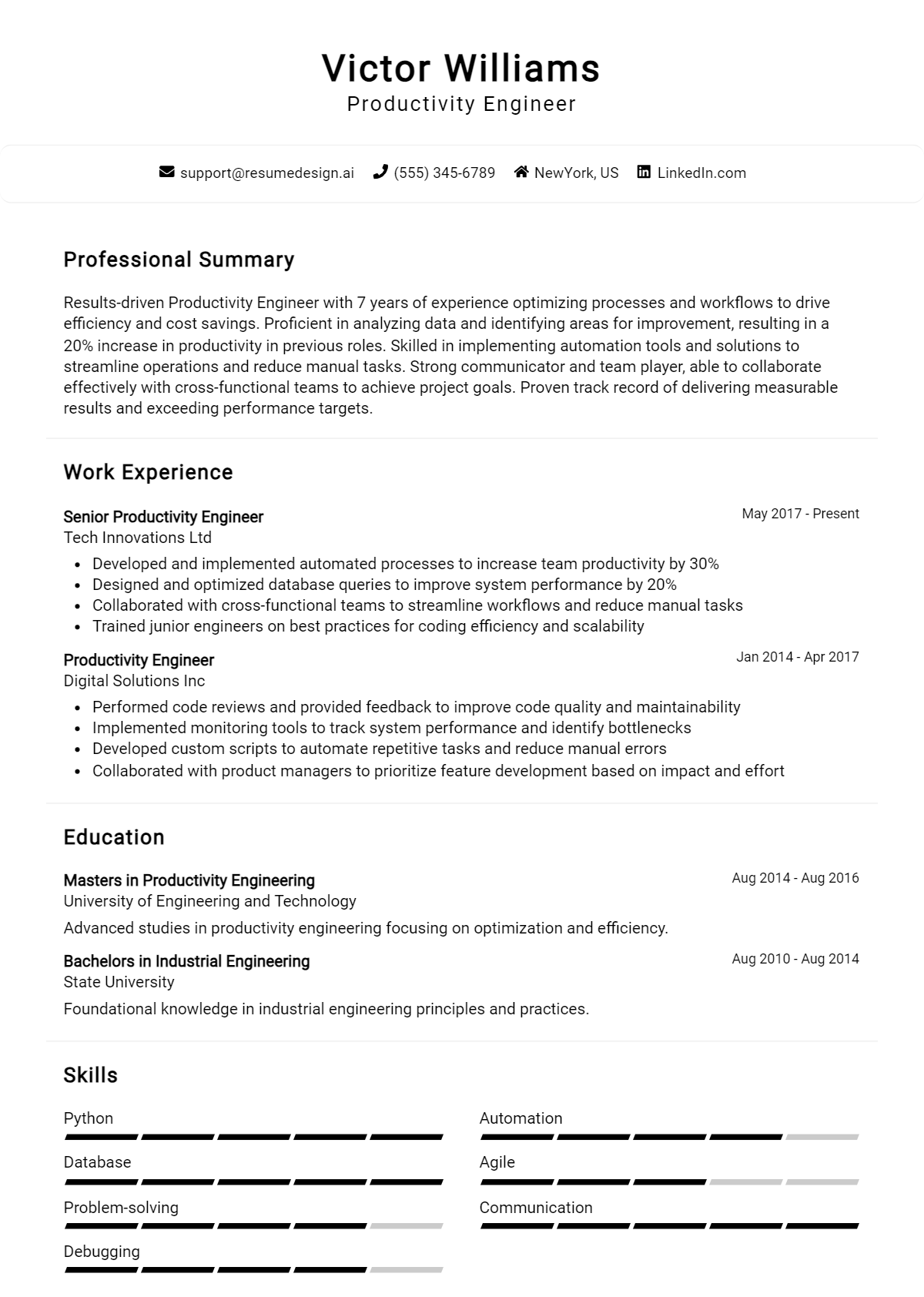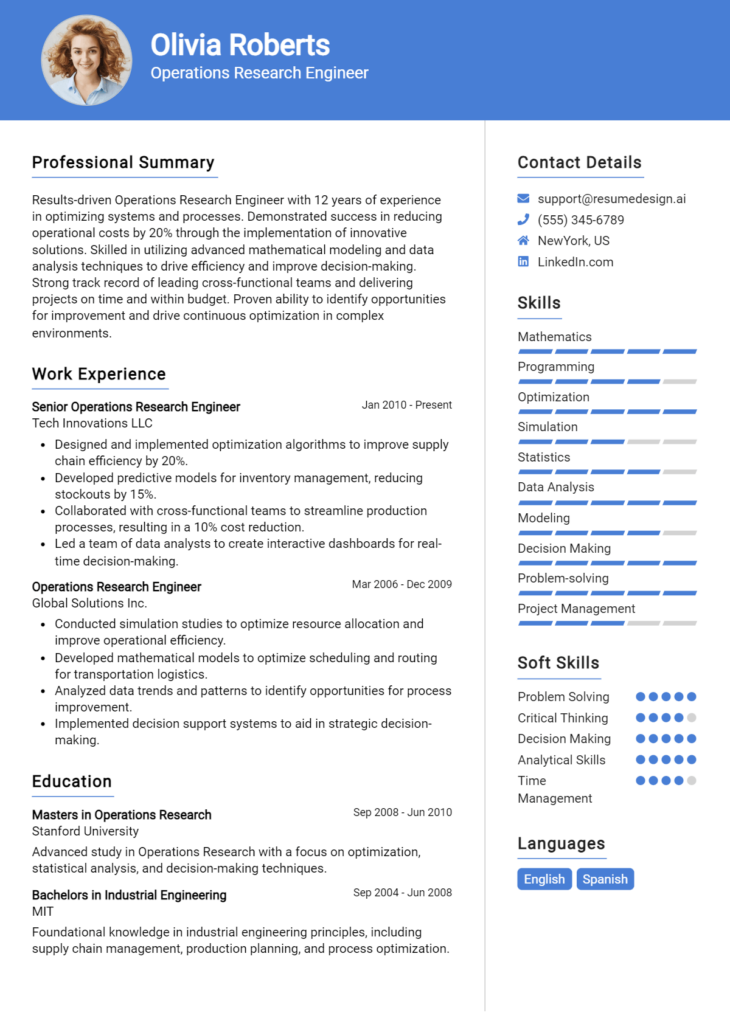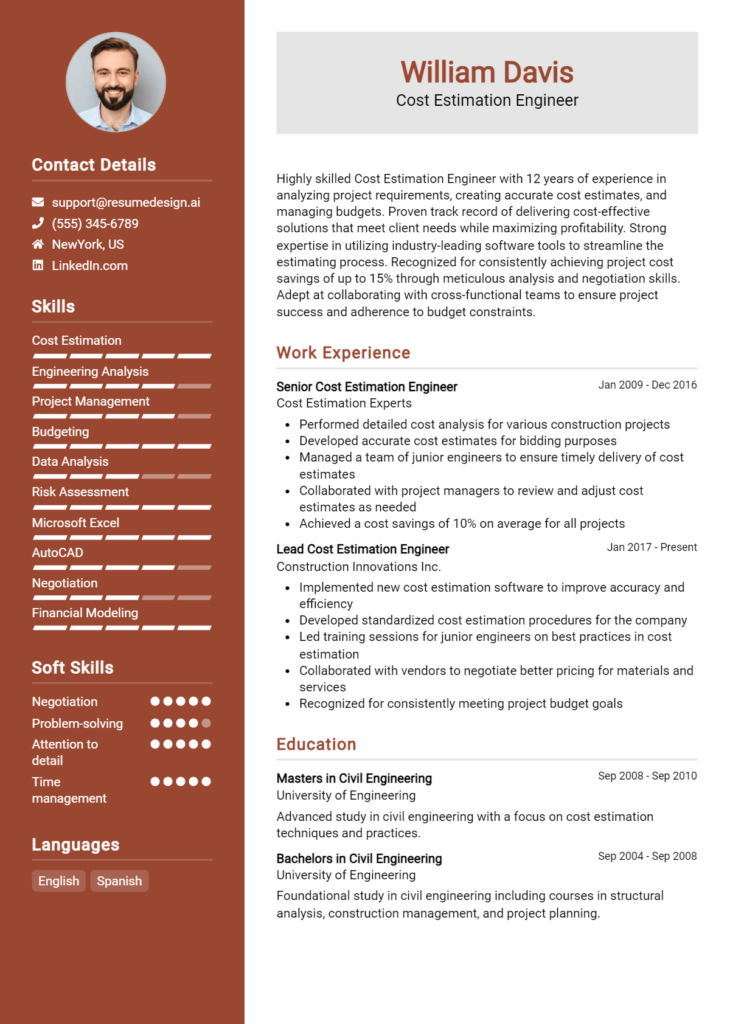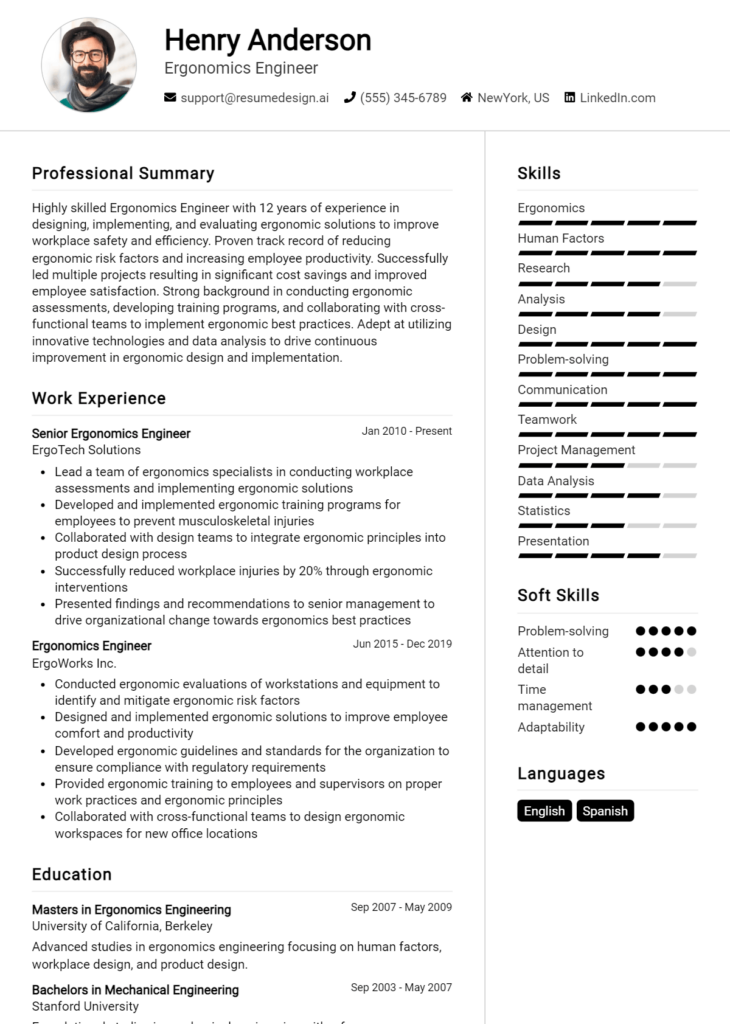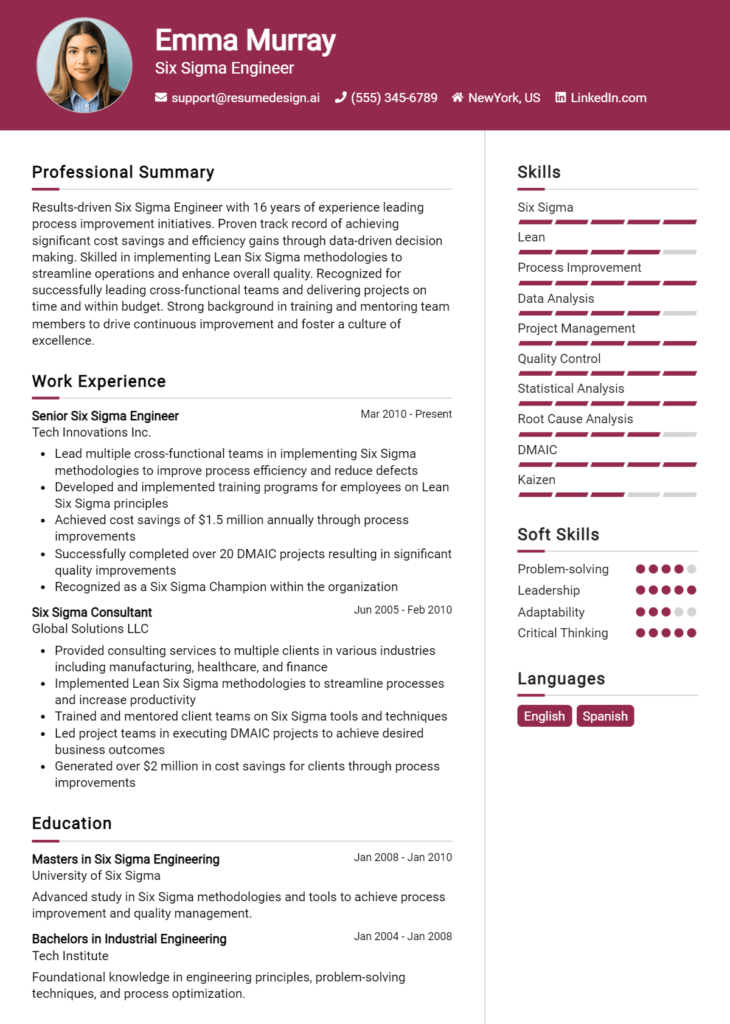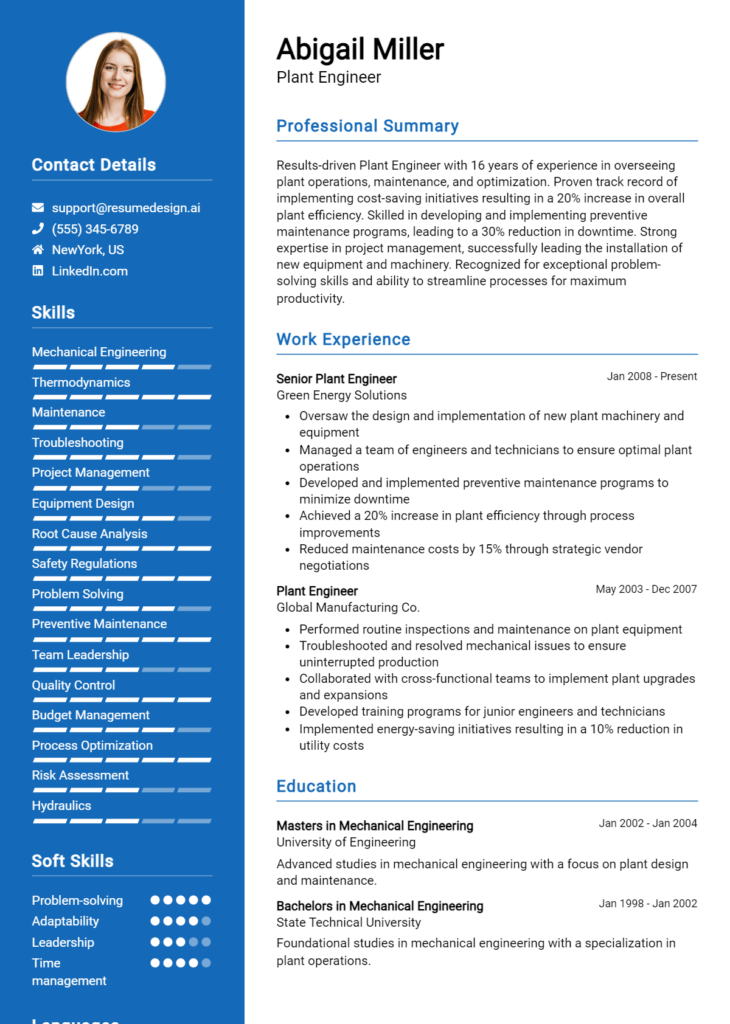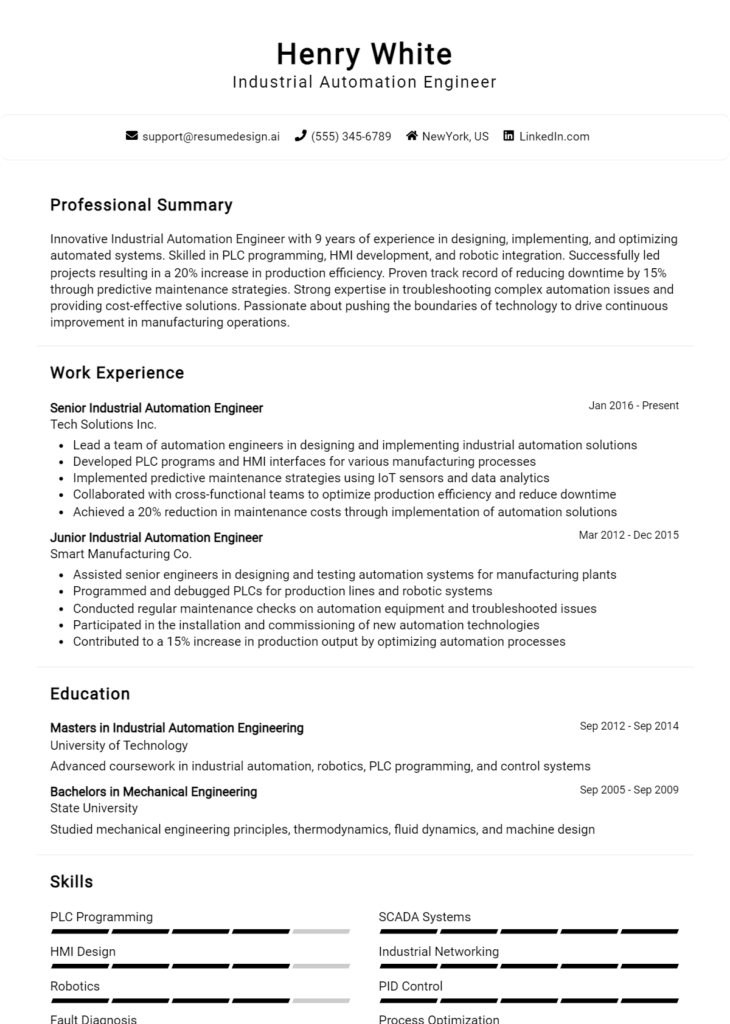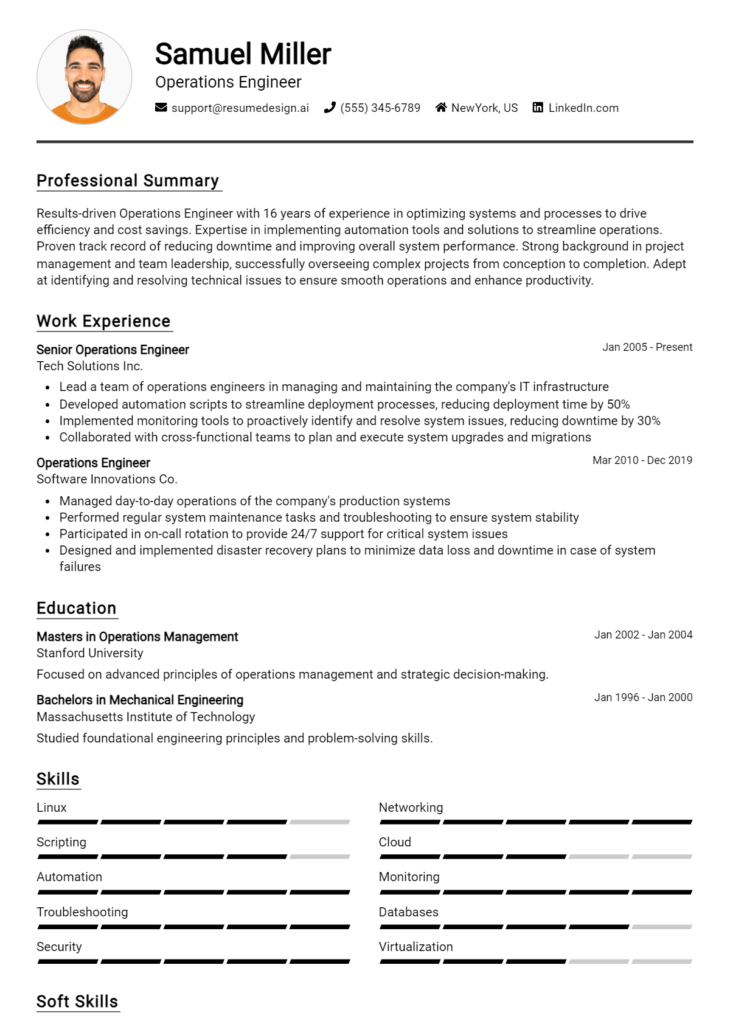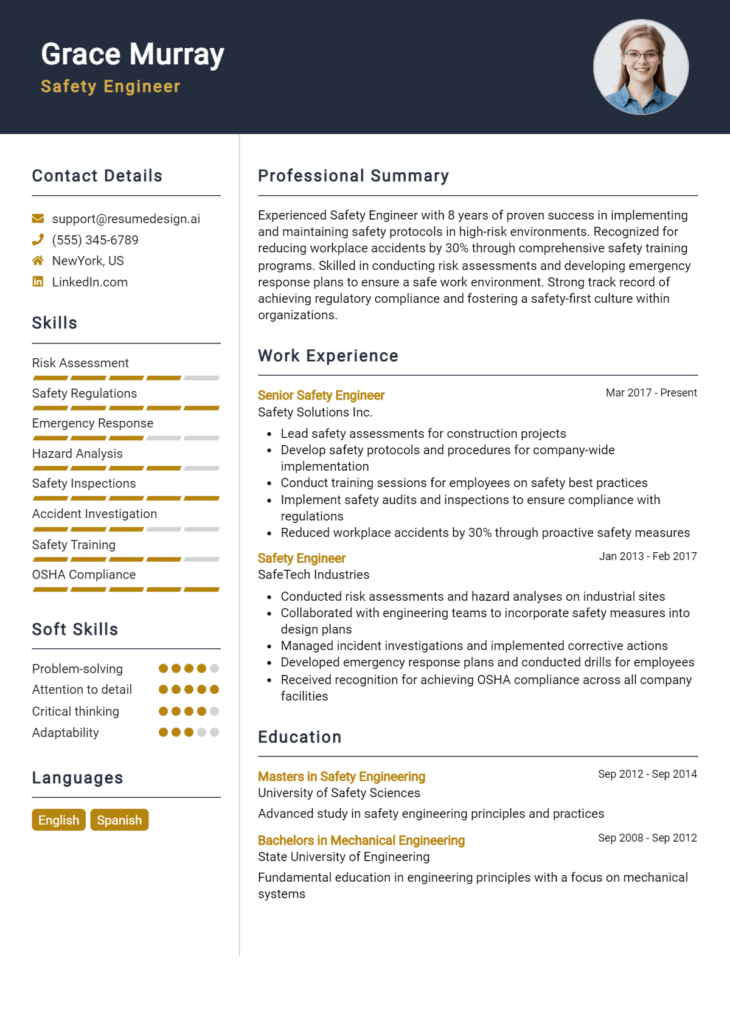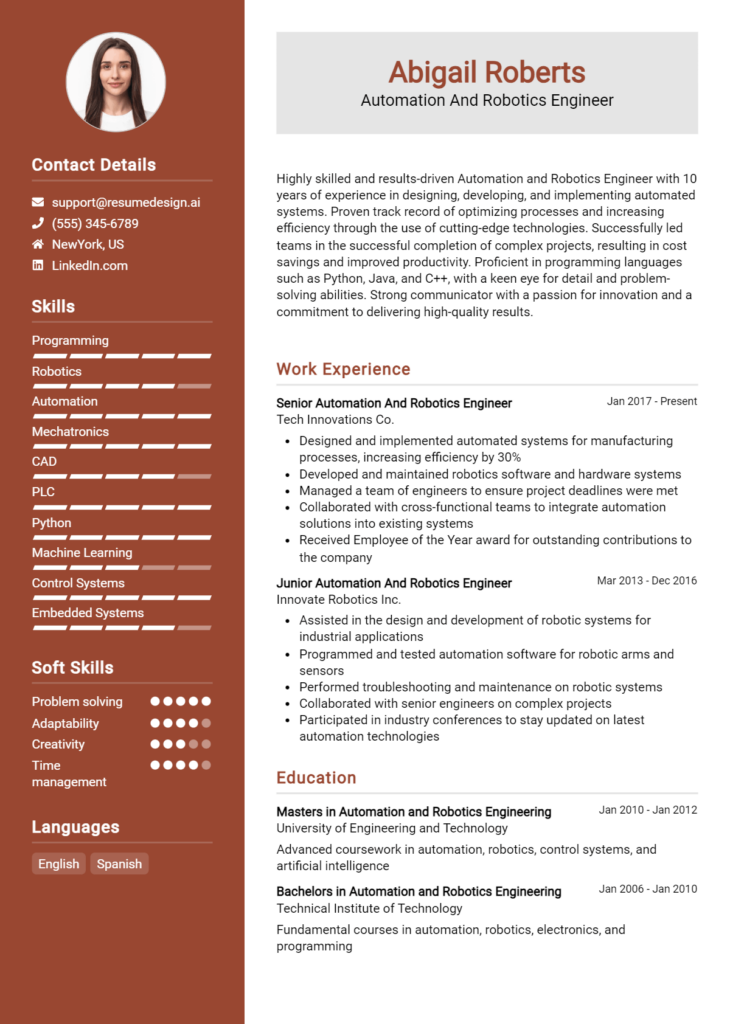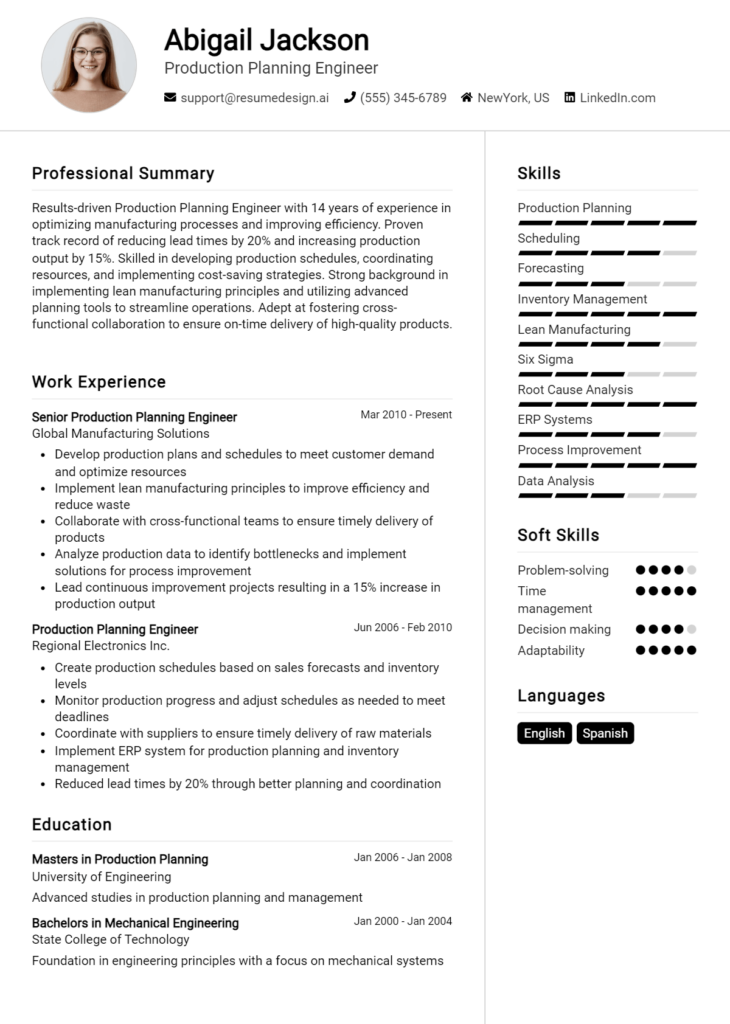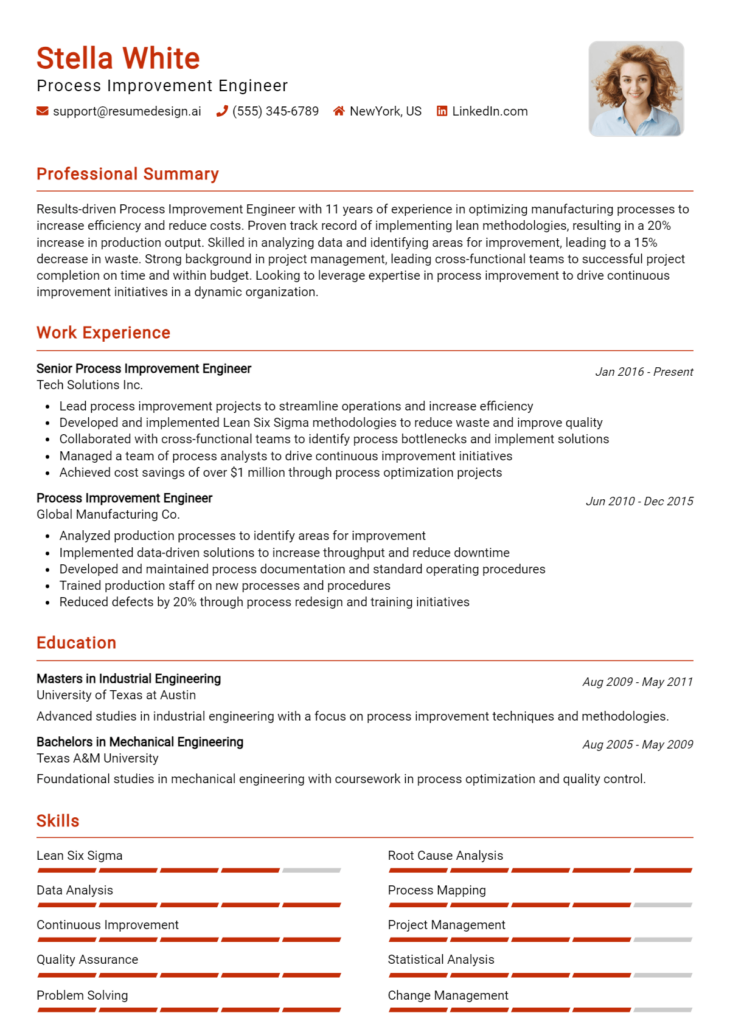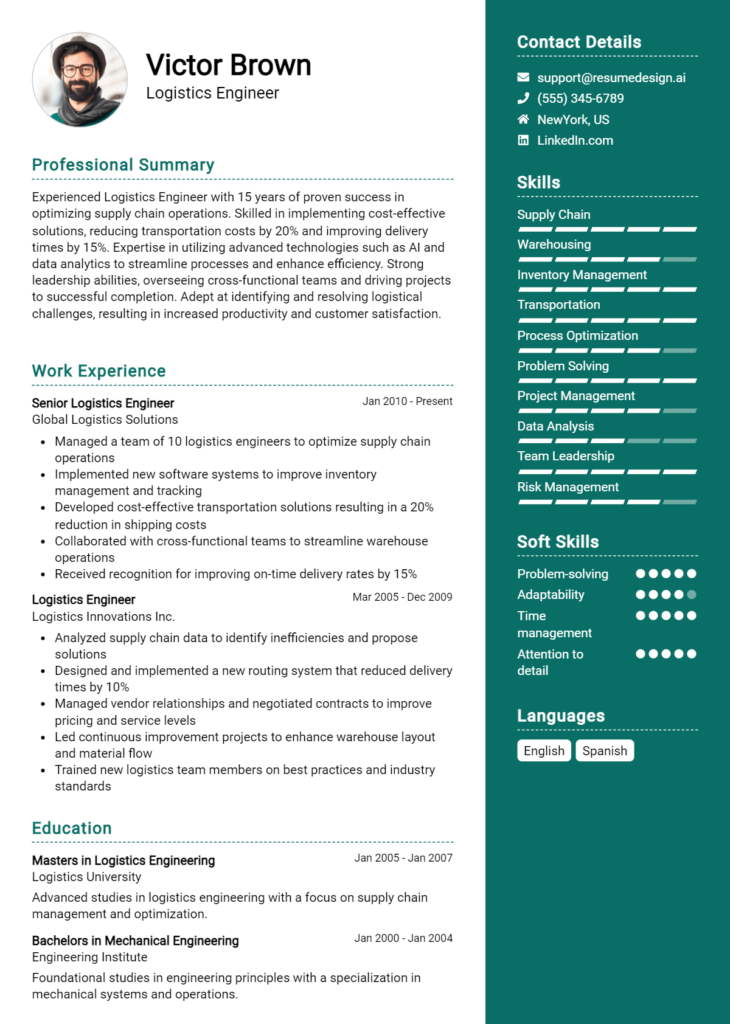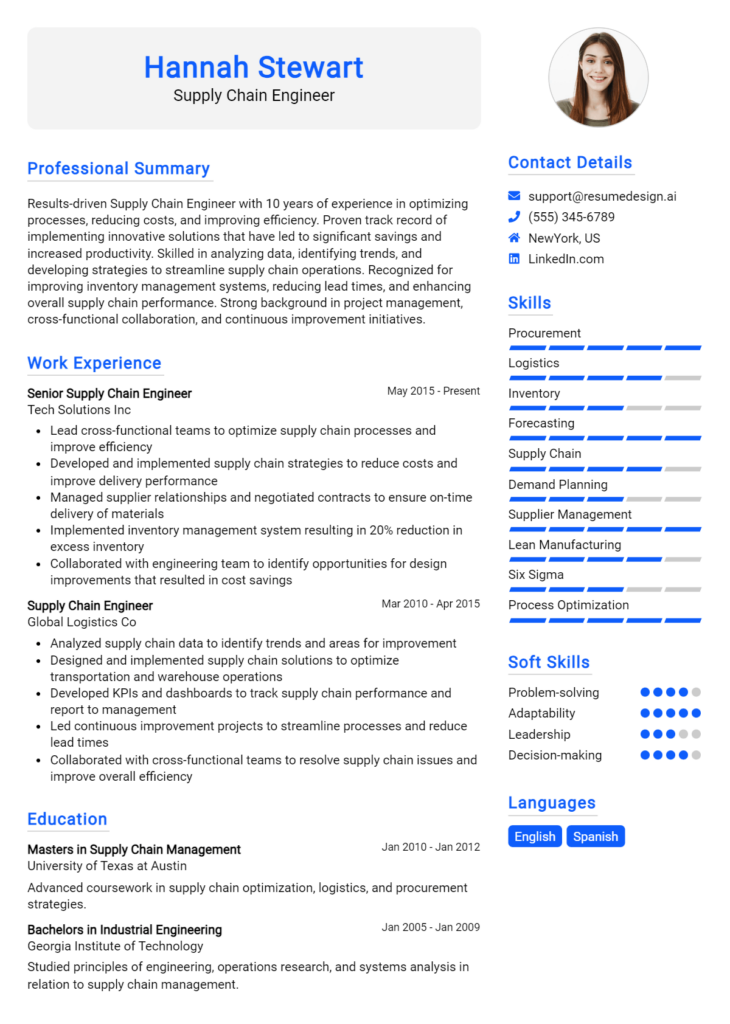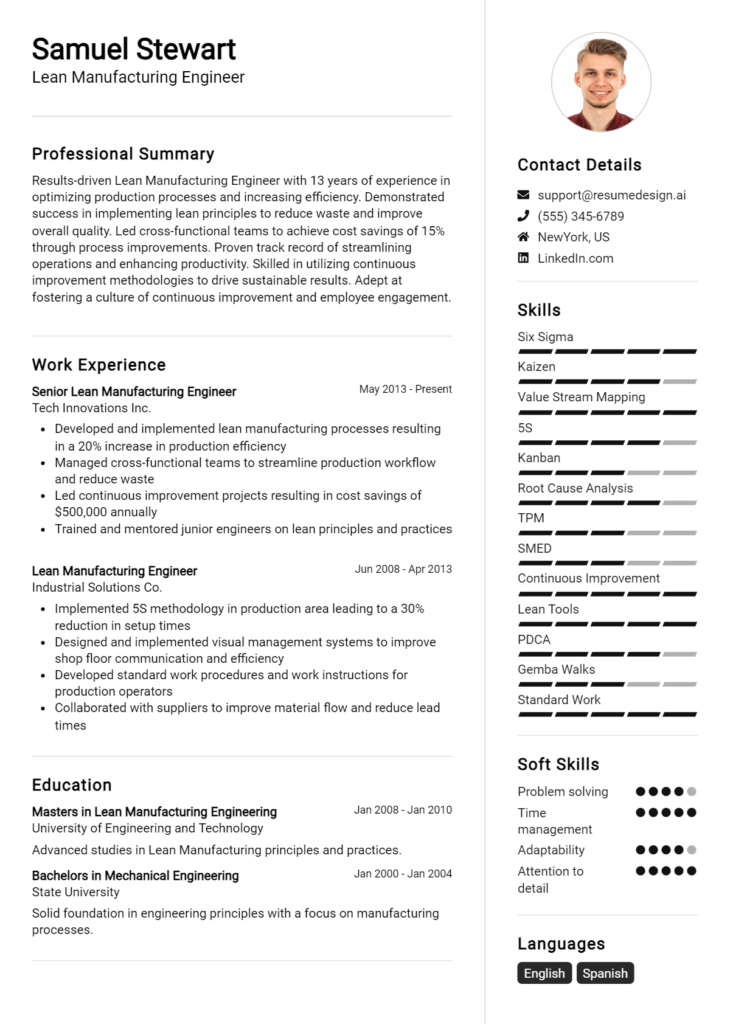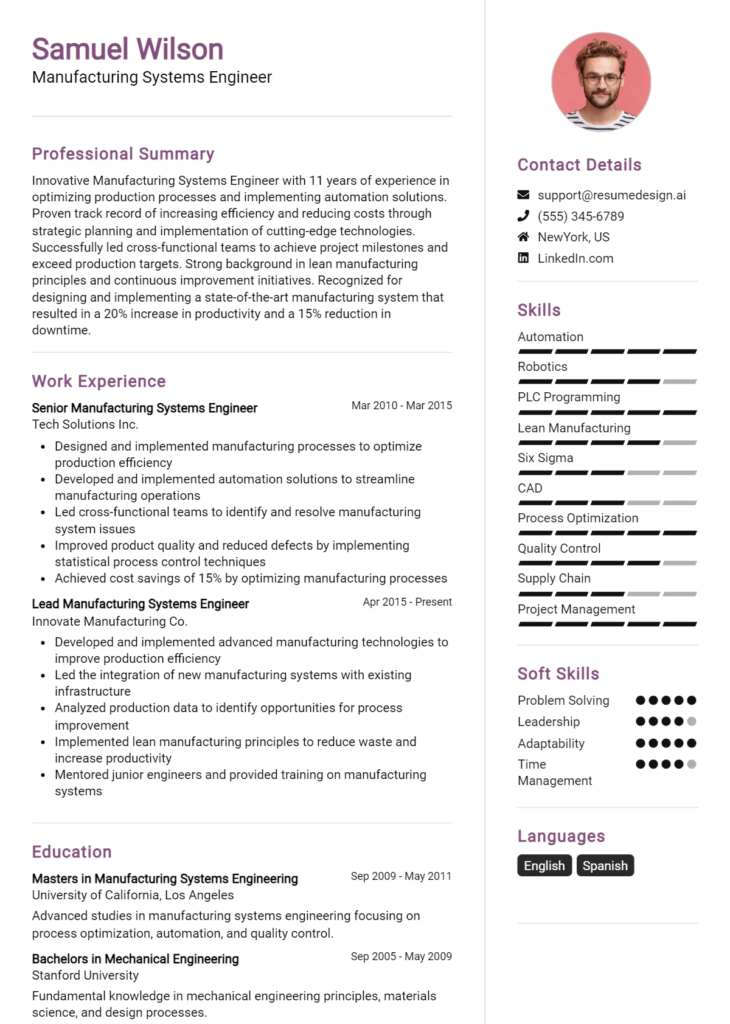Productivity Engineer Core Responsibilities
A Productivity Engineer plays a crucial role in enhancing organizational efficiency by bridging various departments, including operations, engineering, and quality assurance. Key responsibilities include analyzing workflows, implementing process improvements, and utilizing data analytics to identify bottlenecks. Essential skills encompass technical proficiency, operational insights, and strong problem-solving abilities, all vital for achieving the organization’s goals. A well-structured resume effectively showcases these qualifications, illustrating a candidate's potential impact on productivity and efficiency.
Common Responsibilities Listed on Productivity Engineer Resume
- Analyze and optimize production processes for increased efficiency.
- Implement data-driven strategies to reduce waste and improve quality.
- Collaborate with cross-functional teams to identify operational bottlenecks.
- Develop and maintain productivity metrics and KPIs.
- Conduct root cause analysis for process-related issues.
- Design and implement training programs for staff on best practices.
- Utilize simulation software to model and improve workflows.
- Prepare detailed reports on productivity improvements and initiatives.
- Facilitate continuous improvement workshops and team meetings.
- Monitor industry trends and emerging technologies for productivity enhancements.
- Support project management efforts related to process optimization.
High-Level Resume Tips for Productivity Engineer Professionals
A well-crafted resume is essential for Productivity Engineer professionals as it serves as the first impression they make on potential employers. In a competitive job market, a resume must not only showcase technical skills but also highlight significant achievements that demonstrate a candidate's ability to enhance productivity and optimize processes. This guide will provide practical and actionable resume tips specifically tailored for Productivity Engineer professionals, ensuring that they present themselves in the best possible light to prospective employers.
Top Resume Tips for Productivity Engineer Professionals
- Tailor your resume to the job description by incorporating relevant keywords that align with the specific role you are applying for.
- Showcase relevant experience by prioritizing past roles and projects that directly relate to productivity engineering and process optimization.
- Quantify your achievements by using metrics and data to demonstrate the impact of your work, such as percentage improvements or cost savings.
- Highlight industry-specific skills, such as Lean methodology, Six Sigma, or project management tools, to show your expertise in the field.
- Use action verbs to describe your responsibilities and accomplishments, making your contributions sound more impactful and dynamic.
- Include a dedicated section for certifications and relevant training to validate your credentials and commitment to professional development.
- Keep the design clean and professional, ensuring that the layout is easy to read and that important information stands out.
- Limit the length of your resume to one or two pages, focusing on the most pertinent information that aligns with the job you are applying for.
- Incorporate a summary statement at the beginning that succinctly captures your career highlights and what you bring to the table as a Productivity Engineer.
By implementing these tips, Productivity Engineer professionals can significantly enhance their resumes, making them more appealing to potential employers. A well-structured and targeted resume not only increases the chances of landing an interview but also positions candidates as strong contenders in the ever-evolving field of productivity engineering.
Why Resume Headlines & Titles are Important for Productivity Engineer
In the competitive field of productivity engineering, a well-crafted resume headline or title can serve as a powerful first impression for hiring managers. This single phrase captures the essence of a candidate's qualifications and sets the tone for the rest of the resume. A strong headline not only grabs attention but also succinctly summarizes key skills, experiences, or accomplishments that are directly relevant to the position being applied for. By making it concise and pertinent, candidates can effectively communicate their value proposition, thereby increasing their chances of being noticed and invited for an interview.
Best Practices for Crafting Resume Headlines for Productivity Engineer
- Keep it concise: Aim for a headline that is brief yet descriptive, ideally under 10 words.
- Be role-specific: Tailor your headline to reflect the specific position of Productivity Engineer.
- Highlight key skills: Incorporate essential skills or technologies relevant to productivity engineering.
- Use action-oriented language: Begin with strong verbs or adjectives that convey dynamism.
- Showcase achievements: If possible, include measurable outcomes to demonstrate impact.
- Avoid jargon: Use clear language that is easily understood by all hiring managers.
- Stay relevant: Ensure every word in your headline contributes to your candidacy for the role.
- Consider industry keywords: Use terms that are commonly recognized in the productivity engineering field.
Example Resume Headlines for Productivity Engineer
Strong Resume Headlines
Innovative Productivity Engineer with 5+ Years of Experience in Process Optimization
Results-Driven Engineer Specializing in Lean Methodologies and Workflow Efficiency
Data-Driven Productivity Specialist Committed to Enhancing Operational Performance
Weak Resume Headlines
Engineer Looking for a Job
Productivity Engineer with Experience
The strong headlines effectively convey the candidate's unique qualifications and specific focus areas, making them stand out in a sea of applications. By incorporating relevant experience and skills, these compelling phrases immediately showcase what the candidate brings to the table. In contrast, the weak headlines fail to provide any substantial information or differentiation, as they are vague and generic. They do not highlight the candidate's strengths or relevance to the role, which is essential in capturing the attention of hiring managers.
Writing an Exceptional Productivity Engineer Resume Summary
A resume summary is a critical component for a Productivity Engineer as it serves as the first impression on hiring managers. A well-crafted summary quickly captures attention by highlighting key skills, relevant experience, and impressive accomplishments that align with the specific requirements of the job. In a competitive job market, a concise and impactful resume summary can set candidates apart, making it essential to tailor this section to the job description to effectively showcase one’s value to potential employers.
Best Practices for Writing a Productivity Engineer Resume Summary
- Quantify Achievements: Use numbers to demonstrate the impact of your work, such as percentage improvements in efficiency or cost savings.
- Focus on Relevant Skills: Highlight skills that are directly applicable to the role, such as process optimization, project management, and data analysis.
- Tailor for the Job Description: Customize your summary to reflect the specific requirements and keywords found in the job posting.
- Keep it Concise: Aim for 2-4 sentences that deliver maximum information in a compact format.
- Use Action Words: Start sentences with strong action verbs to convey a sense of proactivity and results-oriented mindset.
- Highlight Problem-Solving Abilities: Emphasize your capability to identify issues and implement effective solutions.
- Showcase Industry Knowledge: Mention any relevant industry experience or expertise that aligns with the company’s needs.
- Reflect Professional Growth: Indicate progression in your career, such as promotions or increased responsibilities, to show your commitment and development.
Example Productivity Engineer Resume Summaries
Strong Resume Summaries
Dynamic Productivity Engineer with over 5 years of experience in streamlining manufacturing processes, achieving a 30% reduction in operational costs and a 25% increase in output efficiency. Expert in Lean Six Sigma methodologies and committed to continuous improvement.
Results-driven Productivity Engineer with a proven track record of implementing data-driven strategies that led to a 40% decrease in downtime and a 15% increase in production throughput. Proficient in utilizing advanced analytics tools to optimize workflow.
Innovative Productivity Engineer skilled in cross-functional collaboration, successfully executing process improvements that saved $500,000 annually. Adept at using ERP systems and conducting root cause analysis to enhance productivity.
Weak Resume Summaries
Experienced engineer looking to improve productivity in a company.
I have a background in engineering and want to help organizations become more efficient.
The examples of strong resume summaries stand out because they are specific, quantifiable, and demonstrate a clear understanding of the role's requirements. They effectively showcase the candidate’s achievements and relevant skills, making them appealing to hiring managers. In contrast, the weak summaries lack detail and measurable outcomes, making them vague and generic, failing to capture the unique value the candidate can bring to the position.
Work Experience Section for Productivity Engineer Resume
The work experience section of a Productivity Engineer resume is crucial as it serves as a comprehensive showcase of the candidate's technical skills, leadership capabilities, and ability to deliver high-quality products. This section not only highlights previous roles and responsibilities but also emphasizes the impact the candidate has had in past positions. By quantifying achievements and aligning experiences with industry standards, candidates can effectively convey their value to potential employers and demonstrate their readiness to tackle productivity challenges in a dynamic work environment.
Best Practices for Productivity Engineer Work Experience
- Use action verbs to describe accomplishments and responsibilities, making your contributions clear and compelling.
- Quantify results wherever possible, such as percentage improvements in efficiency or reductions in project timelines.
- Highlight collaboration and teamwork, emphasizing how you worked with cross-functional teams to enhance productivity.
- Align your experiences with industry benchmarks and standards to demonstrate relevance and expertise.
- Focus on specific technical skills and tools you utilized, showcasing your proficiency in relevant technologies.
- Prioritize experiences that illustrate problem-solving capabilities and innovative solutions.
- Keep descriptions concise and relevant, avoiding unnecessary jargon that may confuse the reader.
- Tailor your work experience to the specific job description, ensuring alignment with the employer's needs and expectations.
Example Work Experiences for Productivity Engineer
Strong Experiences
- Led a cross-functional team to implement a new project management software, resulting in a 30% reduction in project delivery time.
- Developed and executed a productivity improvement strategy that increased operational efficiency by 25% within six months.
- Collaborated with engineering and production teams to streamline processes, achieving a 15% decrease in production costs.
- Designed and deployed a data analytics system that improved decision-making speed by 40% and enhanced overall project outcomes.
Weak Experiences
- Worked on various projects to improve productivity.
- Participated in team meetings to discuss productivity enhancements.
- Assisted in some productivity-related tasks as needed.
- Helped implement changes that were suggested by others without specific outcomes noted.
The strong experiences listed above are considered impactful because they provide clear, quantifiable results and demonstrate a candidate's ability to lead, innovate, and collaborate effectively. In contrast, the weak experiences lack specificity and measurable outcomes, making them less compelling to potential employers. By focusing on concrete achievements and technical leadership, candidates can significantly enhance their resumes and stand out in a competitive job market.
Education and Certifications Section for Productivity Engineer Resume
The education and certifications section of a Productivity Engineer resume is crucial for showcasing a candidate's academic credentials and commitment to professional development. This section not only highlights the foundational knowledge acquired through formal education but also emphasizes the industry-relevant certifications that validate the candidate's expertise. By providing details about relevant coursework, specialized training, and ongoing learning efforts, candidates can significantly enhance their credibility and demonstrate their alignment with the specific demands of the job role. Employers often look for candidates who not only possess the necessary technical skills but also show a commitment to continuous improvement and advancement in the field.
Best Practices for Productivity Engineer Education and Certifications
- Prioritize industry-recognized certifications that are relevant to productivity engineering.
- Include a list of relevant coursework that directly pertains to the skills and knowledge required for the role.
- Highlight any specialized training programs or workshops attended that enhance your qualifications.
- Be specific about degrees obtained, including majors and minors that are pertinent to productivity engineering.
- Keep the section concise, focusing on the most relevant and recent qualifications.
- Update the section regularly to reflect new certifications or courses completed.
- Use clear formatting to make it easy for hiring managers to identify key qualifications quickly.
- Consider including GPA or honors for academic achievements if they are impressive and relevant.
Example Education and Certifications for Productivity Engineer
Strong Examples
- Bachelor of Science in Industrial Engineering, ABC University, Graduated May 2022
- Certified Lean Six Sigma Green Belt, International Association for Six Sigma Certification, 2023
- Project Management Professional (PMP), Project Management Institute, 2023
- Relevant Coursework: Operations Management, Systems Optimization, and Process Improvement Techniques
Weak Examples
- Associate Degree in General Studies, XYZ Community College, Graduated 2019
- Certificate in Basic Computer Skills, Online Learning Platform, 2021
- High School Diploma, ABC High School, Graduated 2018
- Outdated Certification: Certified Microsoft Office Specialist, 2016
The strong examples are considered effective because they demonstrate a direct alignment with the skills and knowledge necessary for a Productivity Engineer role, showcasing relevant degrees and industry-recognized certifications that highlight the candidate's expertise and commitment to the field. In contrast, the weak examples reflect qualifications that lack relevance to productivity engineering, either being outdated, too general, or not indicative of specialized skills that employers typically seek in this profession.
Top Skills & Keywords for Productivity Engineer Resume
As a Productivity Engineer, showcasing the right skills on your resume is crucial for capturing the attention of potential employers. Skills not only highlight your qualifications but also demonstrate your ability to improve processes, enhance efficiency, and foster collaboration within teams. A well-crafted resume that emphasizes both hard and soft skills can set you apart in a competitive job market. By incorporating relevant skills into your resume, you can effectively communicate your expertise and readiness to contribute to the organization’s success.
Top Hard & Soft Skills for Productivity Engineer
Soft Skills
- Problem-solving
- Communication
- Team collaboration
- Adaptability
- Critical thinking
- Time management
- Analytical mindset
- Attention to detail
- Conflict resolution
- Leadership
Hard Skills
- Process optimization
- Data analysis
- Lean manufacturing techniques
- Six Sigma methodologies
- Project management
- Workflow automation
- Statistical process control
- Quality assurance
- Performance metrics development
- Familiarity with productivity tools (e.g., Trello, Asana)
By incorporating these key skills into your resume, along with relevant work experience, you can effectively showcase your qualifications as a Productivity Engineer and position yourself as a valuable asset to prospective employers.
Stand Out with a Winning Productivity Engineer Cover Letter
Dear Hiring Manager,
I am excited to apply for the Productivity Engineer position at [Company Name], as advertised on [Job Board/Company Website]. With a solid background in engineering and a passion for optimizing processes, I am confident in my ability to contribute to your team and enhance productivity across various operational facets. My experience in data analysis, workflow optimization, and cross-functional collaboration aligns perfectly with the needs of your organization.
In my previous role at [Previous Company], I successfully led a project that involved analyzing production processes and identifying bottlenecks that hindered efficiency. By implementing lean manufacturing principles and utilizing data-driven decision-making, I was able to increase overall productivity by 25% within six months. This experience honed my skills in problem-solving and reinforced my belief in the value of continuous improvement. I am eager to bring this expertise to [Company Name] and help drive your initiatives toward operational excellence.
Collaboration is at the heart of what I do; I believe that the best solutions come from diverse perspectives and teamwork. I have worked closely with cross-functional teams to develop and implement strategies that not only improve productivity but also foster a culture of innovation and accountability. I am particularly drawn to [Company Name] because of its commitment to embracing new technologies and methodologies, which I believe is crucial in today’s fast-paced environment.
I am thrilled at the prospect of contributing my skills and experiences to [Company Name] as a Productivity Engineer. I look forward to the opportunity to discuss how my background, skills, and enthusiasm for productivity enhancement can make a meaningful impact on your team. Thank you for considering my application. I hope to speak with you soon.
Sincerely,
[Your Name]
[Your Phone Number]
[Your Email Address]
Common Mistakes to Avoid in a Productivity Engineer Resume
When crafting a resume for a Productivity Engineer position, it's essential to present your skills and experiences effectively to stand out in a competitive job market. However, many candidates make common mistakes that can undermine their chances of landing an interview. Understanding these pitfalls can help you refine your resume and showcase your qualifications more effectively.
Vague Job Descriptions: Using generic terms instead of specific responsibilities and achievements can make your experience seem less impactful. Be clear about your contributions and the results you achieved.
Ignoring Relevant Skills: Failing to highlight skills that are directly applicable to productivity engineering, such as data analysis, process optimization, or Lean methodologies, can weaken your application.
Overloading with Technical Jargon: While it's important to demonstrate your expertise, using too much technical jargon can alienate hiring managers who may not be familiar with all the terms.
Neglecting Soft Skills: Productivity engineers often work in teams and need strong communication and problem-solving abilities. Not including these soft skills can leave a gap in your qualifications.
Inconsistent Formatting: A poorly formatted resume can detract from its professionalism. Ensure consistency in font, size, and layout to create a polished look.
Lack of Quantifiable Achievements: Providing numerical evidence of your accomplishments (e.g., "increased efficiency by 20%") can make your successes more tangible and impressive to potential employers.
Using an Unprofessional Email Address: An email address that is too casual or unprofessional can create a negative first impression. Opt for a simple, professional email format.
Failing to Tailor the Resume: Sending a one-size-fits-all resume can be detrimental. It's crucial to customize your resume for each application, aligning your experiences with the specific job requirements.
Conclusion
As we explored the critical aspects of the Productivity Engineer role, it’s clear that this position requires a unique blend of technical skills, analytical thinking, and effective communication. We discussed the importance of understanding production processes, leveraging data to drive improvements, and implementing systems that enhance productivity across various teams. Additionally, the ability to collaborate with cross-functional teams and adapt to changing environments stands out as an essential trait for success in this role.
In conclusion, if you're aspiring to become a successful Productivity Engineer or looking to advance your career in this field, now is the perfect time to ensure your resume reflects your skills and experiences accurately. Don’t miss the opportunity to make a strong impression on potential employers.
We encourage you to review your Productivity Engineer Resume today! To assist you in this process, consider utilizing valuable resources like resume templates, a convenient resume builder, inspiring resume examples, and tailored cover letter templates. These tools can help you create a polished and professional application that highlights your qualifications and stands out in the competitive job market. Take action now and enhance your career prospects!

